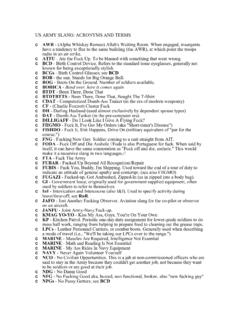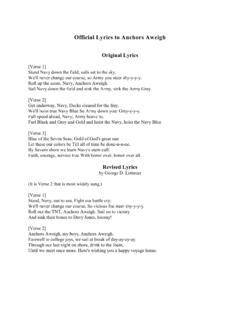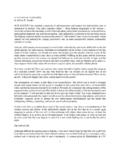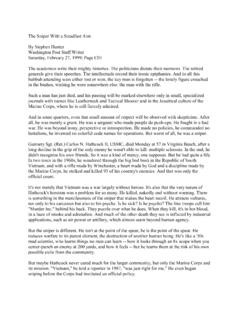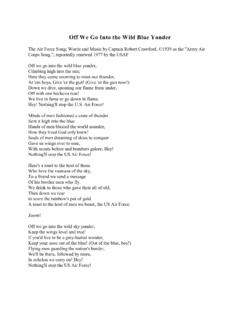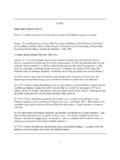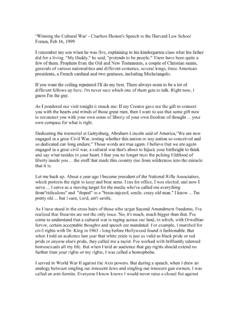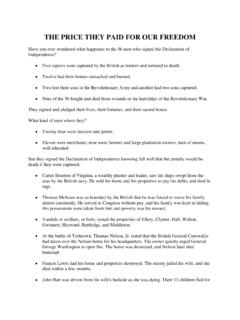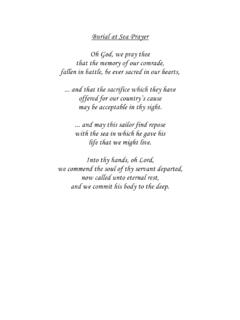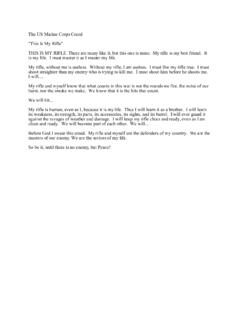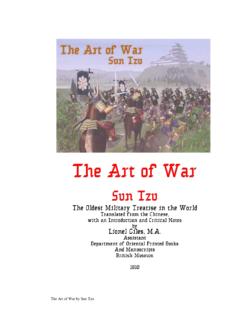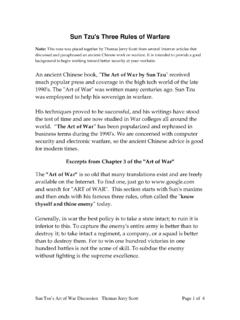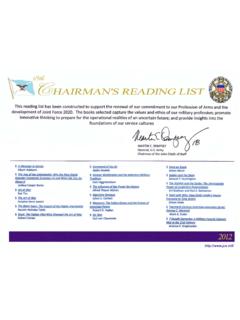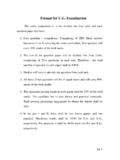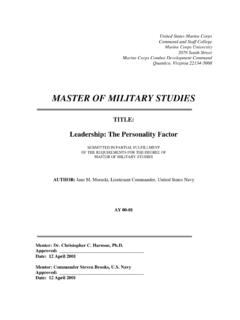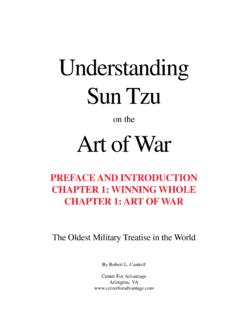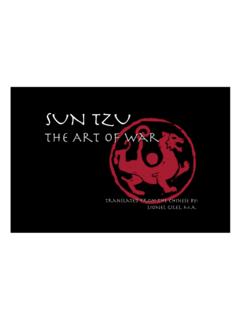Transcription of Fighter Pilot John Boyd - Super Trap
1 Fighter Pilot john Boyd " john Boyd: The Fighter Pilot Who Changed the World." To be published by Little, Brown & Company, Fall 2001. c Robert Coram. All Rights Reserved. Source: PROLOGUE. On the first day of spring, 1997, a somber crowd gathered in the Old Post Chapel at Arlington National Cemetery across the Potomac River from Washington, DC. They came to attend the memorial service for john R. Boyd, Colonel, United States Air Force, retired. Winter often lingers in the hills of northern Virginia. And on that Thursday morning a cold rain and overcast skies caused many in the crowd to wrap their winter coats tighter and to hurry for the doors of the chapel.
2 Full military honors were provided for Boyd; an honor guard in blue raincoats and polished boots, a band, and a flag-draped caisson drawn by six white horses. Boyd was a Fighter Pilot . He wore the Air Force uniform for 24 years. And during that time he made more contributions to Fighter tactics, aircraft design, and the theory of air combat than any man in Air Force history. But on that soft and dreary day when his ashes were laid to rest, the Air Force all but ignored his passing. Only two Air Force officers were in the congregation. One, a three- star general, represented the Air Force Chief of Staff. He sat alone on the front row and was plainly uncomfortable.
3 The other was a major who knew Boyd's work and simply wanted to pay his respects. Neither man had ever met john Boyd. A chaplain opened the Protestant service. Then one by one, three of Boyd's oldest friends, walked to the front of the chapel. Tom Christie, a tall, white-haired man, solemnly read the 23rd. Psalm. Ron Catton, one of Boyd's former students and a fellow Fighter Pilot , delivered the first eulogy. He quoted the poet: "One must wait until the evening, to see how splendid the day has been." He told what it was like to fly with Boyd back in the old days, and his lips trembled and his speech became rushed and he had difficulty controlling his emotions.
4 Some of those present turned their eyes away, stared at Boyd's linen-draped urn, and remembered. There was much to remember. For few men have had such a splendid day as john Boyd. Boyd's friends smiled broadly, a few even chuckled, as they recalled Boyd at his irrepressible best. The chuckles must have puzzled the chaplain. After all, a military funeral with full honors is marked by solemnity and dignity. The slow measured cadences and the history-dictated procedures evoke respectful silence. This is a sacred rite, this final remembrance of a man whose life was spent in the service of his country. Here, levity is out of place. But Boyd's friends came to celebrate his life, not to mourn.
5 And when Pierre Sprey, a small-boned man with swept-back white hair, began a second eulogy by saying, "Not many people are defined by the courts martial and investigations they faced," raucous laughter echoed off the white walls of the chapel. Sprey told how Boyd once snapped the tail off an F-86, spun in an F-100, and not only stole more than $1 million worth of computer time from the Air Force to develop a radical new theory but survived every resulting investigation. Chuck Spinney, a boyish Pentagon analyst who was like a son to Boyd, laughed so loud he could be heard all across the chapel. Even those in the congregation who barely knew Boyd wore broad grins when they heard how he was investigated a dozen times for leaking information to the press and how his guerilla tactics for successful leaking are still being used today.
6 Boyd's young granddaughter, Rebah, was as puzzled by the laughter as was the chaplain. "Why is everybody laughing at granddaddy?" she asked her mother. Boyd's life was marked with a series of enormous accomplishments and lasting achievements. But the thing that meant the most to him over the longest period of time was the simple title he began with almost half a century earlier: Fighter Pilot . He was first, last, and always a Fighter Pilot ; a loud-talking, cigar-smoking, arm-waving, boisterous, bigger-than-life Fighter Pilot . There is no such thing as an ex- Fighter Pilot . Once a young man straps on a jet aircraft and climbs into the heavens to do battle, it sears his psyche forever.
7 At some point he will hang up his flight suit - eventually they all do - and in the autumn of his years his eyes may dim and he may be stooped with age. But ask him about his life and his eyes flash and his back straightens and his hands demonstrate aerial maneuvers and every conversation begins with "There I was at .. ". and he is young again as he remembers his glory days. Those at the memorial service remembered the time back in the middle and late 1950s when john Boyd was the best Fighter Pilot in America. He returned from a combat tour in Korea to become an instructor at the Fighter Weapons School, the Air Force's premier dog-fighting academy at Nellis Air Force Base out in the desert 10 miles north of Las Vegas.
8 There he was known as "40-Second Boyd," the Pilot who could defeat any opponent in simulated air-to-air combat in less than 40 seconds. Like any gunslinger with a nickname and a reputation, Boyd was challenged. Some of the best pilots in the Air Force called him out at one time or another. So did the best pilots in the Navy and the Marines. So did exchange pilots from a half-dozen countries. He took on the best pilots in the free world. But no man could be found who was better in the air than john Boyd. Boyd was more than a great stick and rudder man; he was that rarest of creatures - a thinking Fighter Pilot . Anyone familiar with the Air Force can tell you two things with confidence: One, Fighter pilots are known for testosterone, not gray matter.
9 And, two, military doctrine is dictated by generals. But in 1960 when he was a young captain, john Boyd developed and wrote "The Aerial Attack Study" which became official Air Force doctrine, the bible of air combat; first in America, and then, when it was declassified, for air forces around the world. Put another way, john Boyd, while still a junior officer, changed the way every air force in the world flies and fights. Pierre Sprey told how in 1961 the Air Force sent Boyd back to college for another degree. Boyd chose the Georgia Institute of Technology, one of the tougher state engineering schools in America. Late one night he was studying for an exam in thermodynamics.
10 He and another student were in a classroom on the second floor of the Mechanical Engineering building when Boyd went off on a riff about being a Fighter Pilot in Korea and what it was like to fly an F-86 on triumphant sweeps down MiG Alley. Suddenly the Second Law of Thermodynamics meshed with all that he had learned as a Fighter Pilot and Boyd had the epiphany that became his Energy-Maneuverability Theory. Tom Christie smiled and nodded as he remembered. He was the man who steadied the soapbox for the rambunctious and confrontational Boyd in those tumultuous years of presenting the E-M theory to the Air Force, the years when Boyd became known throughout the Air Force as "the Mad Major.
